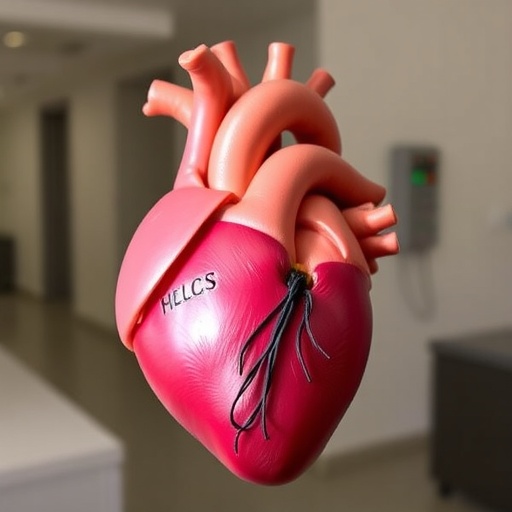
In an unprecedented advancement in cardiac surgery, a recent case series has highlighted the safety and feasibility of partial heart transplantation as a revolutionary treatment for patients with complex congenital heart disease. This novel surgical approach is not just a temporary fix but holds the potential to fundamentally alter how valve replacements are managed, especially in pediatric populations where the natural growth of heart valves is an ongoing challenge. The study, conducted on 19 patients, reveals that partial heart transplants enable the transplanted valves to grow with the patient, circumventing the limitations imposed by traditional prosthetic valve replacements that do not accommodate somatic growth.
Heart valve disease in children with congenital defects has long presented a formidable challenge to cardiologists and surgeons alike. The primary difficulty lies in the fact that existing valve replacement options—mechanical or bioprosthetic valves—do not grow as the child grows. This necessitates multiple reoperations over time, each procedure carrying risks and potential complications. The innovative technique explored in this study directly addresses these issues by transplanting only a portion of a donor heart, specifically focusing on valves and the associated structures. This permits the grafted tissue to grow naturally, maintaining physiological integrity and function over time.
Technically, partial heart transplantation involves surgically excising the diseased valve and implanting a corresponding valve from a donor heart, carefully preserving the anatomical continuity and vascular connections necessary for viability. This differs significantly from conventional heart transplants, which replace the entire heart and often require lifelong immunosuppression. In partial transplantation, though immunosuppression remains necessary, the volume of donor tissue is minimized, potentially reducing some immunological risks and complications associated with full organ transplantation.
The 19-patient case series demonstrated promising surgical outcomes with no immediate procedural mortality and manageable immunological responses. Meticulous postoperative follow-up was crucial to monitor valve function, immunological status, and growth progression. Advanced imaging techniques, such as echocardiography and magnetic resonance imaging, were instrumental in assessing the functionality and morphologic adaptation of the transplanted valves over time. The ability of these valves to grow was confirmed through serial monitoring, representing a milestone in pediatric cardiac care.
One of the most compelling aspects of this partial transplantation technique is its potential scalability and application in a broader clinical setting. Beyond congenital heart disease, valve-related complications in adult patients could theoretically benefit from this approach, especially in complex cases where valve repair or replacement options are limited. However, extensive clinical trials and long-term studies will be necessary to validate these preliminary findings and establish standardized protocols.
Another dimension of this innovative approach concerns the immunological environment of partial heart transplants. Unlike mechanical valves, which are immunologically inert but non-living, partial heart transplants introduce living donor tissue that interacts dynamically with the recipient’s immune system. The study emphasizes the necessity of tailored immunosuppressive regimens to prevent graft rejection while minimizing side effects. This delicate balance will be a focal point of future research, potentially guiding immune modulation strategies for living tissue implants.
The implications of partial heart transplantation also extend into healthcare economics and quality of life considerations. Reducing the number of reoperations by providing valves capable of growth could significantly lower the cumulative healthcare costs for affected patients and families. From the patient’s perspective, minimizing invasive surgeries translates to less psychological stress, reduced hospitalization times, and improved long-term health outcomes.
Moreover, this approach exemplifies the convergence of surgical innovation, immunology, and biomedical engineering. It underscores the importance of interdisciplinary collaboration in tackling complex cardiovascular disorders. The cultivation of a valve graft that integrates seamlessly with the recipient’s circulatory system while allowing physiological growth epitomizes the frontier of personalized medicine in cardiac care.
Looking ahead, the study’s authors advocate for rigorous multicenter clinical trials to further elucidate the safety, efficacy, and long-term durability of partial heart transplantation. Critical questions remain about the longevity of graft function, potential complications such as stenosis or regurgitation, and the impacts of chronic immunosuppression. Additionally, ethical considerations surrounding donor tissue allocation and patient selection criteria warrant careful deliberation.
This pioneering work not only challenges existing paradigms in heart valve replacement but also opens avenues for regenerative medicine strategies that could one day harness bioengineered tissues or stem cell-derived valves transplanted partially to restore cardiac function. The integration of partial heart transplantation into the therapeutic landscape could mark a turning point for patients suffering from debilitating congenital and acquired valve diseases.
Conclusively, this case series heralds a new horizon in cardiac surgery where the restoration of native-like valve function with growth potential becomes feasible. The encouraging data originating from these 19 patients offers hope for a future where valvular heart disease, especially in growing children, can be managed with fewer interventions and better long-term outcomes. Continued innovation, coupled with diligent patient monitoring and immunological management, will be critical in translating this technique from promising case series to standard clinical practice.
This breakthrough represents a beacon of hope for countless patients and a testament to medical ingenuity and perseverance, reaffirming the commitment of the cardiovascular research community to push the boundaries of what is surgically achievable. As this exciting field develops, it will undoubtedly capture the attention of clinicians, scientists, and patients worldwide, driving further innovations that may one day render valve growth limitations a challenge of the past.
Subject of Research: Partial heart transplantation as a novel valve replacement technique enabling valve growth in congenital heart disease patients.
Article Title: [Not provided]
Web References: [Not provided]
References: (doi:10.1001/jama.2025.13580)
Image Credits: [Not provided]
Keywords: Congenital heart disease, Heart, Heart disease, Transplantation, Patient monitoring, Cardiology
Tags: advancements in cardiology for childrencomplex congenital heart defectscongenital heart disease treatmentgrowing heart valves in childrenheart valve replacement challengeslong-term outcomes of heart transplantsnovel surgical approaches for heart diseasepartial heart transplantpediatric cardiac surgery innovationrisks of traditional prosthetic valvessafety of partial heart transplantationvalve replacement alternatives





